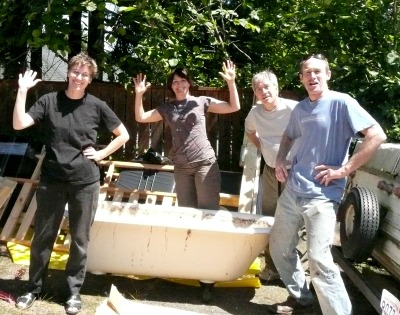
The critical thing is to decide what action you will take on each item - and then do it. It is important to make a list, set deadlines. And don't forget to delegate!
Below are the main items you will have to accomplish before you move. How you deal with them will depend upon your situation.
What you will do with your home depends upon how final you want your move overseas to be.
Do you want to be able to move back "home" in case Panama doesn't work out? Or perhaps you are only anticipating living in Panama for 5 years? Or maybe you simply want to keep your home available for month-long visits and rent it the rest of the year. Your plans will determine the answers to the questions below.
If You Own Your Home:
Will you sell it? If so, when?
Will you rent it? If so, will you manage the rental yourself or hire a property manager?
Yes, you can manage your own properties from abroad. We have done it for years. Of course, it depends upon the location of your home. The greater the demand for the type and location of your rental, the more likely you can successfully manage the rental yourself.
If you do rent your home out, make sure it is in good rental condition. Get all minor repairs done. Make a list of everything you left behind. Ideally, identify a good handyman to take care of any future maintenance issue.
If You Are A Renter:
As a renter, your options are more straight forward.
Give notice, per your lease.
Talk to your landlord about subletting it to someone else, if you want the option to come back
If you are in a lease, talk to your landlord about how break your lease without a penalty. For instance, find someone acceptable to your landlord to take over your lease,
There are many factors to consider when deciding what to do with your possessions. Some items you will bring simply because you love them. Somethings you will not bring because they won't survive your new tropical climate. You may decide you want to start all over and buy most everything you need in your new home.
These are the questions you will need to ask yourself.
What will you bring with you?
How will you bring it with you? (via container ship, via airplane in bins & suitcases...)
If shipping your belongings, research and secure a shipping service. As you pack, keep in mind that you will need to provide an itemized list of the contents. (I highly recommend making that list as you pack - don't rely on your memory.)
If you don’t have a place all ready to move into, what will you do with your possessions until you find a new home? (e.g., Are there any storage facilities where you are going?)
What will you do with your belongings you don’t bring with you?
Not all items do well in the tropics. Overstuffed furniture and leather items do not fare well in the tropics. Photographs and important papers must be kept well sealed. Otherwise, moisture will wreak havoc on them.
You might want to think 3 times about bringing important heirlooms. There is a reason that people who live in the tropics do not own multi-generational heirlooms. This is especially true for items are made of fabric, leather, or paper.
FYI, If you plan on living in a fully-sealed air conditioned home, your possessions will not be impacted by the tropical climate nearly as much.
Shipping your furniture overseas is an expensive option. It can also be a logistical nightmare. This is something to think about. Is it important to you to have your furniture from "home" in Panama?
Before you ship your furniture, go furniture shopping in Panama. Check out what kind of furniture is available. You may prefer to sell your stuff and buy new stuff in Panama. Your old furniture may not even fit in your new home. Something else is to consider buying used in Panama. You can check out craigslist in Panama as well as Facebook groups like Buy Sell Chiriqui.
Our short answer is "no". But there are exceptions.
You can learn more by reading my post on whether you should bring your car to Panama.
Also, for another perspective, you might want to check out what my friend Sheryl says about shipping her car (and her stuff) to Panama. Sheryl is thrilled she decided to ship her car to her new home in Puerto Armuelles, Panama.
If you aren't shipping your car, you may want to read our advice and experience buying used cars in Panama.
Electronics don't last as long in the tropics. As an example, I will describe why a non-electronic controlled fan is a better choice than an electronic controlled fan. There are 2 reasons for this.
I am not saying don't bring electronics. I couldn't live without them.
I have a whole section below on what electronic devices you should bring. I am only suggesting that you minimize the use of items that have electronic controls, when it is an option.
If you decide to store some of your belongings "back home", check out a fixed-term storage option. It is cheaper than the more common self-storage solution. You cannot visit your storage unit as freely and easily. But you won't have to since you'll be living in Panama.
The Goodwin family have written up some great tips on packing and moving overseas on their site. I have included many of their packing tips and some of my own below.
Pack your gear in plastic bins. Not only do plastic bins serve as sturdy shipping boxes, but once unpacked these can be used in your new home in various ways. They can be used as storage bins, end tables, foot stools, and more. Going to your local store and picking up bins in Panama, may not be as easy as it is "back home.
The Goodwins highly recommend using Sterilite Footlocker bins because they are both light-weight and sturdy. They zip-tied them closed for the journey. We also used bins as packing containers when we moved to Panama. I am still using them as storage bins for extra clothes, art supplies, and holiday decorations. We used Rubbermaid bins, but I think the Sterlite footlockers would have served us better.
Vacuum bags. Yes, use vacuum bags to make your stuff smaller. But remember, it won't make your things lighter. Something to keep in mind if you are trying to keep below that critical 50lb max for each suitcase or bin that you check in on the airplane.
Luggage scale. Speaking of that sweet 50lb mark, you may want to buy a luggage scale. If I knew they were so reasonably priced, I would have bought one years ago. I have been relying on my husband's great sense of weight. He can usually guess a suitcase's weight within half a pound. As he is not always available, I would prefer to use a scale. Check out this well-reviewed and inexpensive luggage scale.
Organizing baskets, bins & containers. Think about how you organize your possessions now. You probably use a variety of bins, baskets, containers for your clothing, jewelry, spices, and more. It is so much easier to set up your new home if you have those organizing items immediately available. If you have room to pack containers that will lay flat in your packing bins, you will be very happy. I wish that I had included alot more organizing bins. Ikea has a number of collapsible bins. You can also find bins on Amazon.
Collapsible wagon. The Goodwins have a fantastic tip for people with kids under 11 years old. They used a collapsible wagons as one of their free carry on “strollers”. Great to haul kids and carryon through the airport, as well as on the streets of your new town. It works best if you put a piece of plywood on the bottom. They used an Ozark folding wagon, but I think this wagon may be a better choice.
Relocating your pet involves a lot of paperwork and hoops to jump through. Given your moving to do list, I’d highly recommend using a service to guide you through this process. In Panama, PanamaPetRelocation.com is excellent.
You might want to check them out. I have also written about diy pet relocation.
Consider finding a new home for your pet. Not all animals will thrive in the tropics. You might want to start this process early so you can be sure to find a loving home for your pet.
Register a forwarding address with the post office (friend or family member, or mailing service)
Research and decide on a mailing service to use (Choose one that will scan your mail so you can read it online.)
Find an accountant who specializes in doing overseas taxes.
Of course, you can usually find an accountant in your new country that specializes in doing taxes for expats. There are a few good tax services in Panama. Make sure that they are comfortable doing your return without requiring that you visit their office. Be sure they can file all signatures and paperwork electronically.
You may want to ask your accountant these questions.
You can also do your taxes using online programs such as Turbotax. These days you can usually call all the institutions that send you tax statements and get necessary tax information by phone, or have it emailed to you. If you use a mailing service, you can request that they open and scan all your tax-related correspondence.
As always, keep all receipts. If your moving expenses are being paid for, this is especially important.
Make sure all outstanding bills are paid. Leave money and/or checks with a friend or relative to settle any bills that you may have missed.
Be sure that you will be able to do all your banking online. You are going to be managing your money online, so do a test before you leave.
Set up automatic bill payments with your banks and other entities (such as utility companies) for payments you will be making while you are away.
Get a direct phone number of your personal banker, at the branch where they know you. I have found having easy access to a bank manager who knows me well to be invaluable.
Ask how you can lower or eliminate bank ATM withdrawal fees while overseas
Inform financial institutions of your move (bank, credit cards, insurance, etc)
You going to need a lot of documents. Getting a visa, entering your child in school, getting married, and getting a driver's license will all require you to have various documents. These documents will often need to be stamped, translated and notarized.
Review the documents that are required for anything you can imagine needing to get done. Bring these with you.
Translations
Ideally, you should have all relevant documents translated and stamped by a notary. However, there are certified translators in Panama who can do legal translations. There are also online resources for translations; for instance, Languages International.
Documents You May Need
Get a Binder For Your Documents
But all these documents together in a binder with plastic sleeves. The plastic sleeves will protect your documents from humidity and coffee spills. It is a huge plus to have all your documents in one easy to locate blinder. However, it is wise to leave copies of everything with a trusted friend "back home" too.
When going to a government office to submit documents, bring the whole binder with you. An agency will often tell you all the items you need to submit to get whatever authorization you need. But once you arrive at their office, it is very common for them to suddenly remember about yet another required document. If you bring the binder, you will have whatever they need, saving you from making another trip.
Make Copies
As I've mentioned, be sure to make copies of all your documents. Give the copies away. Always keep the originals.
Research and purchase your health insurance. I discuss health insurance options for expats elsewhere on my site.
Find out what the local names or their equivalents, for any prescription medication you or your family are taking. Discover if they are available in Panama. If not, arrange to take a supply with you. Sometimes customs or security will ask to see proof that you need that medicine. Bring a document to show them.
As you consider your health insurance options, it is helpful to learn about the health care system in Panama. In this post I also discuss the system, types of health care insurance in Panama and how to decide which, if any, to use.
Leave someone you trust with copies of your important documents and access to your money to pay any forgotten about bills. Make a master list of passwords, bank information, online accounts, etc. Of course, you can also keep that information in the cloud somewhere, but sometimes you won't be able to get access to Internet.
Although, most things can be taken care of from overseas, sometimes having someone on the ground with all the needed information is a much better option. It is best to keep both options open.
You also may want to give someone you trust a power of attorney in your home country. You can make it both limited in scope and within a specific timeframe.
This is important. Electronics and Internet communication will be a much bigger part of your life in Panama. It is for me.
I count on MagicJack, Skype or Whatsapp to communicate with people back home. I can also use my Panama cell phone or land line, but it is much cheaper with MagicJack, Skype and Whatsapp.
Keep in mind, you can get power cords, chargers, and more that are higher quality much more readily and cheaper in the States.
Electronics To Bring
About Unlocked Cell Phones
Owning an unlocked cell phone will make your life much easier. I have 2 SIM cards. One for the States and one for Panama. I simply switch the card for the country I am in, but I keep all my contact and other information on my phone.
You can continue to use a long-term cell phone service in both countries. For along time we did not. In the US, we used SimpleMobile and MetroPC. You can also use a service that allows you to buy a specific amount of minutes for calls and texting, say $10. That is the way we have mostly done it while in Panama. We use Movistar cell service. You can buy service via card in $1 to $25 increments. We usually buy service $5 at a time. You can also subscribe to a monthly service. I currently subscribe to Movistar's monthly service for $17 a month, which includes Internet.
Elections in your country of origin can still impact your life overseas. You probably want to vote in those elections. You should find out what you need to do to vote from overseas before you move. For Americans, I wrote about how to vote from overseas in this post.
You will need to do some planning if you want to work in Panama. I wrote suggesting some ideas about working and earning money in Panama.
If you want to keep your job, find out if getting a transfer or working remotely is an option. If it is possible, talk with your boss as soon as you can. Be ready to explain exactly how and why working from Panama would be mutually beneficial.
If you plan to get an online job, it is best to get the training, and the job before you move. There are various customer service, medical transcription, and other legitimate jobs you can do via your computer from Panama. Jordan talks about how to teach English online while living in Panama.
Transitioning from the typical lifestyle in a first world country to Panama is simple, but there are many details that need your attention.
Think about all the various aspects of your life. Does anything need to be resolved or attended to before you move overseas? Add those items to your to do list.
My biggest advice is to relax.
Don't take your to-do list too seriously.
Although it is best if you think of everything and check it all off your to do list, the world won't end if you don't.
We were nowhere near as organized as we "should" have been when moving to Panama.
You can take care of alot of things once you are in Panama. Also, this is where a trusted friend or family can help. They can assist in doing all the things you forgot to do, or didn't have time to accomplish.
Prioritize & Slow Down
Focus on accomplishing the things that must be done by you, and only you, before you move.
It is time to get into the pace of life you will be living in Panama.
As someone who goes back and forth from the States to Panama, I much prefer the slower lifestyle of Panama. It is much more relaxing and humanizing. You might as well start enjoying that lower stress lifestyle now.
El Rey, the parent company of Romero, has had it yearly dog shows in other locations. This year is the first time that the Romero in Puerto Armuelles has joined in the celebration.
It was a popular event. I was there early in the day for this video. Around noon or 1, I passed by and there were many more people and dogs. The manager told us there were all sorts of prizes for the winners in each category.
The day before, on Saturday, was Puerto Armuelles monthly dog clinic. A group of Puerto Armuelles residents and a vet from David volunteer each month to spay and fix dogs. I previously did an interview and a post about Puerto Armuelles Spay & Neuter Clinic. My husband has helped them round up stray dogs in the past to spay and neuter.
You can also bring your dog to seen by the vet at the clinic. Which is why we were there.
I made this brief video to give you a glimpse into life in Puerto Armuelles. I hope you enjoy it.
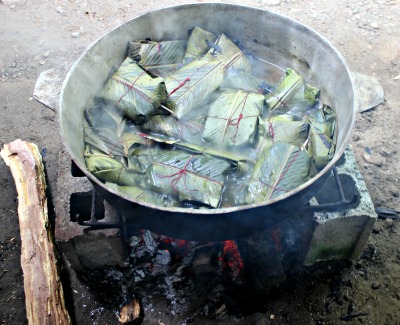
The first time I had Panamanian tamales I was under-whelmed. I had a real fondness for tamales, Mexican tamales.
Initially, I was not thrilled with the wetness of tamales in Panama. It is definitely more messy to eat than a Mexican tamale. Of course, it didn't help that whomever had made them had skimped on the chicken. It was mostly cornmeal.
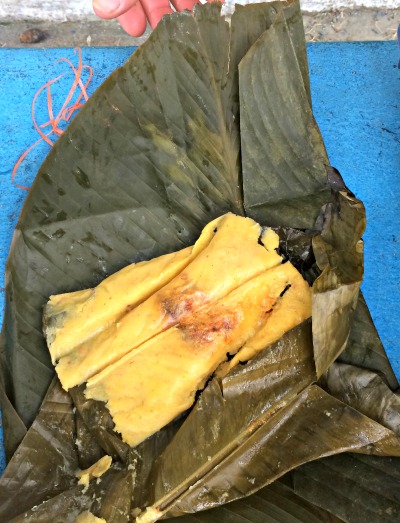
Over the years, I have grown to appreciate how much more flavor the "messy" cornmeal gives to the tamale. They cook the cornmeal in a well-spiced broth which gives it the flavor.
Now, whenever we find someone who is selling tamales we buy a few. We have learned now who puts an adequate amount of chicken in the tamales. And more importantly, who does not. I have never seen a tamale here made of anything but chicken.
I was visiting a family recently and saw these tamales cooking in their back yard (see photo). They made the tamales to feed a work crew at their house.
Making tamales takes quite a bit of work. Most people only make them during the holidays. It is a social activity, like cooking a meal for an American Thanksgiving.
To find out more, Kris of The PanamaAdventure blog, did a great post about tamales. You can find a recipes by using our friend, Google. This recipe uses only simple kitchen utensils.
[leadplayer_vid id="579D1CD0E3480"]
Betsy: Hey, Milton.
Milton: Good morning.
Betsy: I was wondering if you could tell me why you decided to move and live in Puerto Armuelles?
Milton: It's such a beautiful place. It's very friendly. The people here are very friendly. It's just a warm environment.
The climate's great. Of course, the ocean is beautiful.
It's just a nice place to live, and it's an easy place to live.
Betsy: Do you have any advice to give people who are thinking about moving to Panama or to Puerto Armuelles?
Milton: Yeah, I would say come down and visit, rent a house, stay for six, seven months, a year.
If you really like it, then buy something. But you really wanna get in touch with your environment and what's going on in your community. Just to double check and make sure that this is gonna fit your lifestyle.
And when you come down, make sure you stay at Heavenly's Hotel. We'll treat you right.
Betsy: Anything else you wanna say to people who are thinking of moving to Puerto Armuelles or Panama?
Milton: Again, Panama has so many things to offer.
It's a very easy place to do the transfer. They use American dollars, which is very easy for expats.
Also, there's many Visa programs for you to become a Jubilado or you can become a friendly nation Visa. They'll pretty much welcome you in, which has a lot of benefits as well.
Betsy: Thank you very much, Milton.
Milton: You're welcome. Thank you.
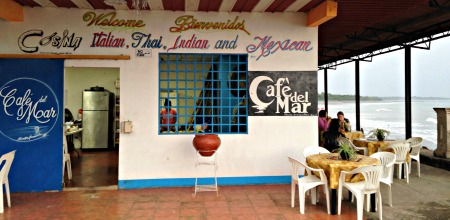
Puerto has a new waterfront restaurant, Cafe del Mar.
As the photo shows, it serves Italian, Thai, Indian and Mexican food, as well as hamburgers.
My family and I ate there after running into a couple who raved about it. They had been there 4 times in one week! And people have also told us they like the restaurant. Overwhelmingly people recommended ordering the dish Thai On On.
When we went the service was very courteous and prompt. We were served by the 2 owners Bernard and Ricardo. Bernard has lived in Puerto Armuelles for years. He is Iranian and speaks English well. Ricardo has had restaurants in both Bocas and David. He has minimal English. Both men are good hosts.

We ordered 2 dishes, the lasagne and, of course, the Thai dish, Thai One On. You can see what they looked like in the photos. Normally, the Thai dish is made with chicken or fish, but they were out of both and used ground beef instead. They asked us if that was okay first.
It was wonderful to have food with flavors you cannot get when eating out elsewhere in Puerto Armuelles. It was interesting that the Thai dish was in the form of a burrito, but it worked.
See their menu in the photos below.
We found our food greasier than we like, but that could be because of the substitution of ground beef for the usual chicken in our dish.
They emphasized that one of their specialities are liquado and batidos, similar to smoothies and milk shakes. But we didn't feel like having them a dinner.
Since then we have had their liquados (but not their batidos) many times. Ricardo makes them best. They only use natural fruit with no added sugar, which is wonderful. I have tried their mango, pineapple, and watermelon liquados. I like Mango the best. Others in my family favor watermelon. They don't always fruit in stock for all the flavors they offer. Some day soon we will have to try their chocolate batido.
The Cafe is open every day, except Tuesday. They usually open at 11, although occasionally not until 1pm. They are open for snacks, lunch, and dinner.
Cafe del Mar overlooks the water at Puerto Armuelles's downtown waterfront park. It is right next to the bus station. If you are at the park, looking at the water, the cafe is on your left.
We go to that park just to sit and watch the water a few times a week. So having a place to sip a liquado is a good plus. In fact, until about a year ago, there had been a small cafe that served liquado in the same location. It didn't offer much in the way of food and their liquados were very sweet. Cafe del Mar's liquados are far superior to those.
You can call Bernard to order take out or to pre-order - 6751-5028.
Business is good at Cafe del Mar. But both Ricardo and Bernard anticipate that their business will do even better once Del Monte comes to town. Del Monte will put more money in the pockets of everyone from banana pickers to management. That money will be spent all over town, including at Cafe del Mar.
If you haven't heard yet, Del Monte is nearing the end of a very long government process to allow Del Monte to produce bananas here. Del Monte will be taking over the old Chiquita Banana plantations. Read more about Del Monte growing bananas in Puerto Armuelles, Panama.
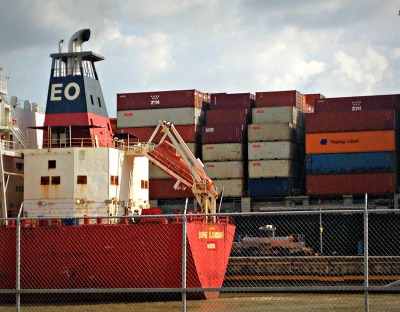
I am particularly interested in ways to keep a shipping container's living space cool, comfortable, and affordable in the tropics.
I recently heard that you can buy a used shipping container in Panama, delivered to your site in Puerto Armuelles, for under $3000.
This price appears to fluctuate widely based on the global economy.
When business is booming, containers are scarce, and thus expensive. When markets are down, there are more abandoned containers since there are fewer goods to be shipped.
As far as shipping containers are concerned, I do have a bit of experience. I have both fixed up a container as a basic living space and visited some high end container living spaces.
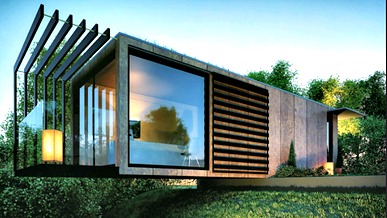
A couple of my Seattle designer/builder friends have created “gourmet” shipping container buildings. I have visited those units. So I have experienced how a shipping container can be transformed into an artistic home.
One of my friends, Hartman Kable, created a modernistic take on the surfer “shack” using a shipping container. It has been featured in various magazines, including Make Magazine's video below. The publicity earned Hartman a trip to the east coast to do another similar project for a high end client.
I like that Hartman kept the look of the container. He didn't radically transform the container so that it was hard to see that the base building material was one or more shipping containers.
Hartman gives a tour of his cool container surf shack in Make Magazine's video below. I'd recommend skipping their very long intro and going directly to Hartman's tour at minute 1:25.
[leadplayer_vid id="579B56D30E20D"]
(Note, Hartman built this on the Olympic Peninsula in Washington State, which has a very different climate than Panama does. You would need to add air conditioning to use something like this in Panama.)
When I was commercial fishing in Alaska, I spent 2 summers living in a shipping container. The container was delivered and leveled right next to the cabin of my employer. This was on the bluff above the mouth of the Egegik River on Bristol Bay in SW Alaska.
One of my pre-season projects was to outfit this 40’ container as a combination net shed, work shop, and crew quarters. The remodel had to be simple because of our very limited supply of building materials. We had to use what we had since we were out on the tundra above Bristol Bay, about 200 miles away from Anchorage, .
The container was an insulated refrigerated model with teak paneling and floor. (Note: most containers are not insulated). It cost $1000 at the time, delivered to our site. So it was affordable. Certainly cheaper than building a similar structure out of more typical materials.
In our wide open, cool, windy tundra base camp, the container was perfect. I put a heater in it. I easily stayed warm. I slept very well since I was always exhausted after the days work. (A long day being 20 or 30 hours of fishing without sleep.)
The container was a secure cocoon in an environment where the wind often blew 50 miles an hour. Our summertime high air temperature was usually around 50 degrees Farenheiht, and the water temperature was in the mid to high 40’s. In a word, my container building was “snug”.
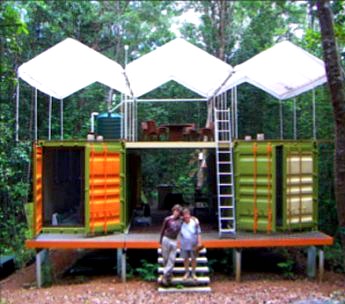
Conversely, in our tropical environment here in Puerto Armuelles, “snug” is not a good thing.
If you look at an indigenous tropical hut, what you will observe is a roof and support for that roof. Not much more. There might be some lightly woven mat walls or bamboo to provide some privacy from neighbors, and a little extra shade.
Generally a good building type for the tropics is a lot like an umbrella. Shade, Shade, Shade, plus, protection from the rain.
In a perfect tropical world, walls are not necessary at all. They are a hinderance to air flow and evaporation. We northerners mostly like them, because they afford privacy, and security.
In fact, while Panamanians are often cold at night and in the early morning, most northern immigrants, except in the highlands, do not require walls for warmth. Our need for walls is generally for privacy, security, and in large part, because we grew up in houses with walls. We just think that houses “should” have walls.
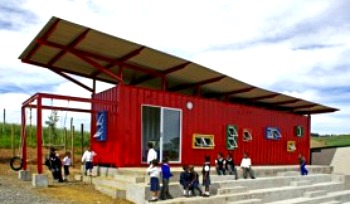
The challenge is how to make a cool and comfortable container house in Panama.
The easiest way to do this is to keep the sun off your container. Solar gain is the biggest factor in hitting up your container home.
A site called containerhomeplans.org specifically discusses what to do to keep your container cool in Panama and elsewhere.
Read more details at containerhomeplans.org here and on this page.
As I have mentioned, ventilation and air flow is a huge factor in keeping living spaces cool. Tropical houses are typically designed to maximize air flow for this reason.
To achieve adequate cooling air flow in a shipping container, requires that you modify the container. One example of what that could look like is seen in the South African classroom photo.
However, if you like the idea of closing up the container as a secure pod, you cannot do that. (Watch the video above to see how Hartman is still able to secure his container using the original container doors.) You will need to use air conditioning. You may even want to use a portable air conditioner so you can safely store the A/C unit inside the container.
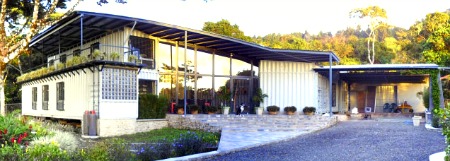
Successful Container Housing In Panama
People have been successful in creating container housing in Panama. A couple who created a home using multiple shipping containers near El Valle, Panama. They detailed how they built it in their blog.
It took them 5 years to create their container home (see photo). In the end, the amount of work they did to create their container house means that it is not the cheap and easy option that attracts so many people. They are currently selling their home for more than half a million dollars.
My Opinion
In short, my opinion of shipping container construction in low-land tropics is low. I don't enjoy living in air conditioned spaces with low ceilings. It seems clear that without a tremendous amount of work, that is the type of container house you must live in here.
I don't think using a shipping container is a good option for a pleasant home here in Panama. You can build a much more pleasant Panama house using cement - and it is affordable. You can either use formed and poured, or concrete block (the most common method) for your new home.
Containers do make great tool or other storage, if you can find one at a good price. Keep in mind that, if left in the sun, the interior temperature of a shipping container is likely to reach 160 degrees Fahrenheit. Of course, you can build a roof over your shipping container to provide some protection from the sun.
If anyone has more information, contacts, or websites to share, I am certainly eager to learn more about shipping container construction. I think our readers would also be interested.
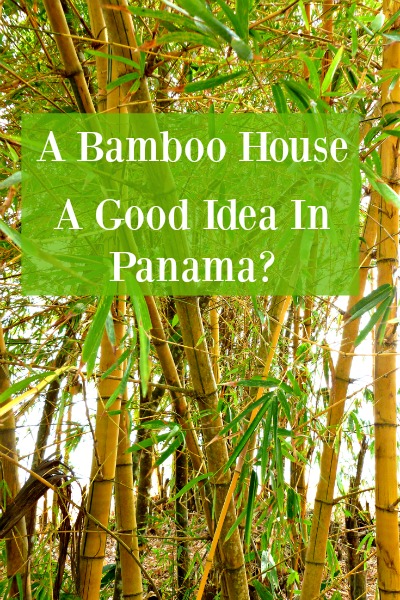
Before moving to Panama, I was already quite familiar with bamboo from my travels in Southeast Asia and while building houses in Japan.
In both Hong Kong and mainland China, I have seen bamboo scaffolding rising up 15, even 20 stories. In Indonesia, I've seen bamboo used for construction of airy pole buildings.
My only real bamboo construction experience has been with Tonkin cane from Vietnam. I still have some Tonkin cane stored along the side of my home in Seattle. It is left over from a fence I built 18 years ago.
Tonkin cane is solid, with literally no hollow core.
The bamboo has been stored outdoors in Seattle’s moist and mild climate for 18 years. It appears to have aged hardly at all. The fence that I built from this bamboo is in nearly the same good condition. Though it has been exposed to sun, rain, high and low temperatures for nearly two decades, I have only replaced a couple of canes in all those years.
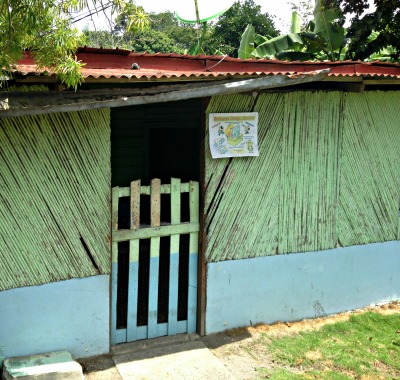
We get plenty of rain and abundant sunshine here in Panama. It is an ideal combination for bamboo habitat. In fact, some of Panama's timber species grow 20 or 30 feet annually and can reach up to 8” in diameter.
In our town of Puerto Armuelles Panama, you can typically get timber bamboo 60 feet tall and 3”-5” in diameter (see photo).
The price is wonderfully affordable. A 60’ length of timber bamboo only costs ~$1.50. Unfortunately, you wouldn't want to use it to build your home.
This is because Panama's timber bamboo has a mostly hollow structure. Which mean it does not last long when used as the exterior of structures.
Most bamboo that I have encountered in Puerto Armuelles, and generally in Panama, appears to be some strain of fast-growing golden bamboo.
Panama's most common bamboos are prone to dry out and crack in the dry season. It also degrades rapidly when exposed to sunlight and is prone to mold and rot.
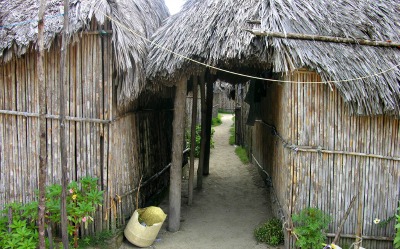
As these 2 photos show, the bamboo typically used to build homes in Panama is what is easily grown and harvested here. A fast-growing golden bamboo.
It is not the type of bamboo that North Americans think of as appropriate for construction. That is because it is not. These are not permanent structures. These homeowners know they will need to replace the bamboo in these small houses every few years.
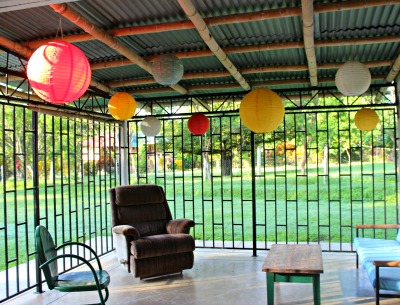
However, sometimes a temporary building structure is just want you need.
We often use timber bamboo as temporary bracing or temporary fencing on our projects. I have made a couple of temporary sheds and a carport with it on our own property or in situations where I am “checking out” a design idea.
Since each 60’ length of timber bamboo costs about $1.50, it is a great, low cost, temporary building material. If it is protected from the sun and rain, the bamboo appears to last several years.
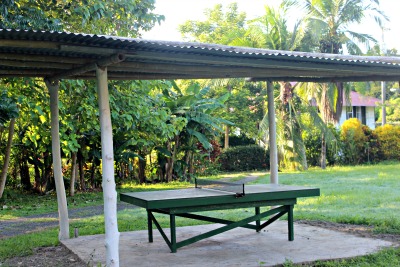
As you can see in the living room photo, we even use it in our own home. The bamboo you see in the photo is about 8 years old. We have replaced the bamboo on top of the zinc roof once in those 8 years. (Note: This open-air living room was added during the remodel, the rest of the house is 2 stories.)
I have seen photos online of beautiful bamboo structures in Costa Rica and other tropical countries.
In fact, I met a German man who has built a Bamboo house just over the border, on the beach in Costa Rica. I have yet to visit his project and find out more about it. I do know that he brought in a builder from a high-end area of Costa Rica who specializes in bamboo construction for expats. It is still on my “to do” list to visit his home and find out what strain of bamboo he used.
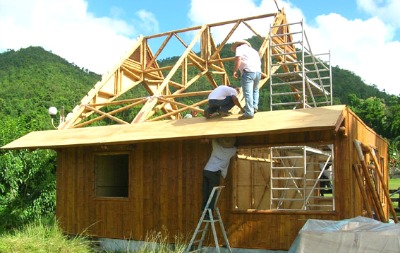
There are roughly 1500 known bamboo species on the planet. However, only a hand-full of them can be used for construction.
In Latin America, including Panama, the yellow striped bamboo, Bambusa vulgaris 'Vittata', is everywhere. Sadly, due to its hollow core, it cannot be used for construction.
The best construction-worthy bamboo grown in Latin America is the Guadua Angustifolia. Unfortunately, it is not a popular crop. Teak is much more popular.
People have been growing teak as an income-crop for many years. Until that changes, there likely won't be a much high-quality Guadua Bamboo available in Panama. Because there isn't much of this bamboo for sale, it will cost you more than you probably want to pay.
However, there seems to be sufficient Guadua Bamboo available in nearby Costa Rica (see Rudy's comment in the comment section).
Until it is more widely available in Panama, that may be a good option. You would have to investigate any import taxes you might have to pay to bring the bamboo over the border into Panama.
Of course, you can import the construction grade bamboo you need from various sources.
At least one of the sources I used to write this post (see below), offers to deliver construction grade bamboo to your building site in Panama. My guess is that cost of importing bamboo, relative to other construction materials, will be expensive. But it does seem worth checking out the cost.
The good thing is if more people want to build with Bamboo, more people will produce it, hopefully in Panama. This increase in supply will decrease the cost of bamboo.
Hopefully, building high-quality bamboo construction in Panama will stop being a luxury construction method.
With a greater supply of construction grade bamboo in Panama, bamboo can become an excellent way to build an attractive and affordable eco-friendly house.
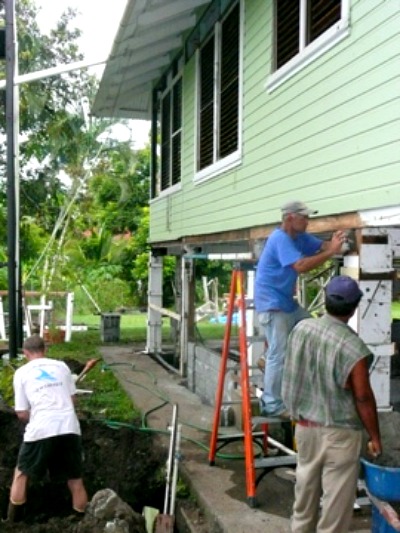
Wood is a great way to build in the highlands of Panama, such as in Boquete and Volcan. Or a place where there is a desire for an insulated wall cavity to contain fiberglass insulation. In the highlands, builders are pretty familiar with wood construction methods, so finding good carpenters is possible.
On the warmer coast of Panama, unless you are air conditioning the whole house, the insulative quality of a 2x4 cavity is not of much benefit.
Having adequate ventilation is far more critical in the warmer lowlands of Panama.
Moisture can collect in unventilated wall insulation. This leads to wood rot and provides a breeding ground for unhealthy mold spores.
As I mentioned, a key reason not to build with wood is termites. Termites are more pervasive in Panama's warmer coastal regions than in the highlands. To be fully protected from termites, any wood used in construction needs to be pressure treated with arsenic, or some equivalent insect repellant. This means that the entire wood structure of your homes would be built of a highly toxic, non-environmental safe material.
If this is not an issue for you, chemically-treated wood is available in nearby David. It is usually imported from Canada. Keep in mind, that it is expensive.
You can use locally available hard woods that are naturally more resistant to pests, but they are just resistant, not impervious. You will have to tend to your wood on regular basis by injecting poison where you see evidence of termite infestations. If you don't do that, your house will slowly be eaten from the inside out.
Wood is definitely not a low-maintenance or low-cost building material choice in Panama. For all these reasons above, we are not using wood as our primary construction material in our Living In Panama House.
Keep in mind, whether you build with wood or not, roof insulation as protection against thermal gain from the sun is needed in both the highland and lowlands of Panama. Solar gain is the main source of the excessive heat in the tropics.
Having said all this, if I were to build a two story structure, I would use both concrete and wood. Concrete for the 1st floor and pressure treated 2x’s for the 2nd floor. The upper floor would be mostly open air with very little wall.
Costs More to Build & Maintain
A house built with both materials is more costly.
Also, finding skilled carpenters in Panama is more of a challenge than finding skilled masons.
Our family likes the ideas of a multiple story house made of wood and concrete. We are toying with building ourselves a 3 story “tree house” on one of our lots by the beach. Of course, we have to assess how much effort we are willing to put into the endeavor.
We are not the only expats who have chosen to remodel a wood house in Panama. There are a few other expats in Puerto Armuelles who have remodeled one of the 2x4 framed Chiquita Banana houses. I believe each of these owners had a lot of construction experience in the US, prior to moving to Panama. So the wooden houses appeared to be familiar terrain to them.
In each case, the owner-builder ended up either doing much of the carpentry himself or had to train his crew from scratch. This is because the labor pool knew nothing about high quality wood construction. Alternatively, they had to accept a grossly inferior product from an incompetent local carpenter. Most of these projects resulted in a combination of the 3 methods above.
One fellow, who is doing a beautiful job remodeling a house in our neighborhood, has been working on his house for over 3 years, and it is still not finished. This fellow is a superb craftsman and the house project is beautiful. However, from my point of view, it is too much money and too much effort. I have spoken with this guy many times over the course of the project. He has said that he would not attempt the project, if he had it to do over.
Our own situation is not dissimilar, although we did not forge ahead quite so doggedly. Our own wooden Chiquita house remodel is only half finished. After six months or so, I finally just fired the crew.
Today, I don’t think too much about my half finished Chiquita Banana House. If I do think about it, I see 2 possibilities for our home. 1) I will complete the project myself, over time, rather than employ locals to do the finicky carpentry. 2), more likely, we will continue to live in the half-remodeled structure.
Our house works fine as it is. In fact, we love to live in it. It feels sort of like living in a huge, well-ventilated artists loft apartment. We have loads of space (about 3500 square feet on two floors).
Not finishing my wood house remodel allows me the time to focus our construction efforts on our beach properties. As a rough comparison, I estimate that I can build 5 or 6 open air, concrete beach houses in the time that it would take to complete the remodel of our wooden Chiquita Banana House. Plus, I think concrete construction is a lot more fun and a more productive use of my time, money, and creative energy.
If you do decide to use wood to build your house, you may want to go the wood and concrete route. Except for the posts, and ceiling structure, the whole bottom floor of our Chiquita Banana house is made of concrete.
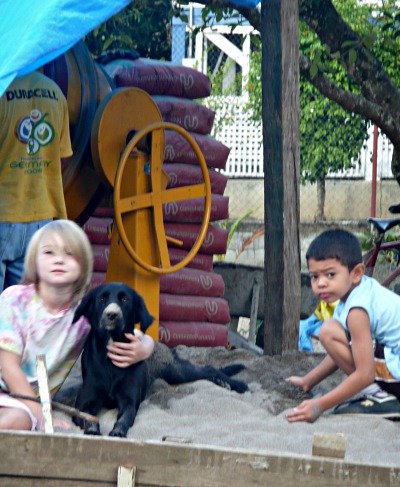
Which is why cement is the typical building material of all of Latin America.
It is also what we use as the primary construction material for our Living in Panama House.
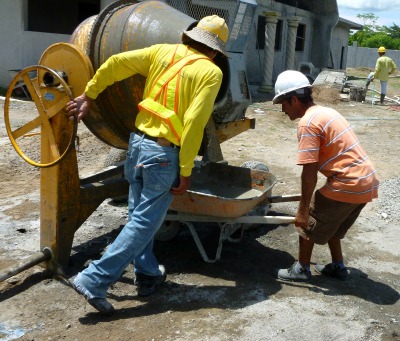
It is wise to keep your construction project within the comfort zone of the local workers. Builders in Panama are most comfortable working with concrete.
Think of Panama as a small town of 100 years ago, where folks are used to doing things the same way, generation after generation. Of course, they can learn new ways, but it won't be a fast, easy, or necessarily successful process.

Concrete block is the most common method of construction. It is usually reinforced with steel rebar and the hollow cells in the blocks are filled with a concrete slurry.
Standard concrete blocks are 16” long and are available in 4” and 6” thicknesses.
Half blocks may be purchased to maintain the overlapping rhythm of the block structure. Block may easily be cut with a grinder, or scored and broken to size. (This is the most common method both in Panama and in North America).
As I mention in another article on hardware stores, the quality of block available in Puerto Armuelles varies greatly from supplier to supplier, and even between batches from the same supplier. You need to inspect each shipment, and even every block. Some blocks literally fall apart in your hands, while others are perfectly adequate, especially if you use plenty of steel reinforcement, and fill all cells with concrete.
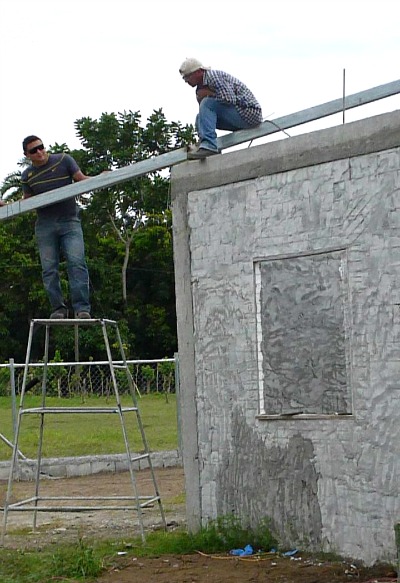
Please note: No block that I have encountered in Panama is of the high quality that one would encounter at a typical home center, or concrete supplier in the States or Canada.
However, I believe that in the very near future, as with everything else in Panama, the quality of local block will rise to the level of that in North America. The growth rate and improvements in quality in Panama are like nothing I have seen anywhere in my lifetime. The pace of growth and modernization in Panama is truly astounding.
Custom Blocks In Puerto
Our best block supplier has agreed to provide custom blocks using a higher ratio of cement to aggregates than his standard block. He will make it your specifications.
In other words, we can start getting that higher North American- quality block in Puerto Armuelles today.
M2 or Convintec is a insulated Styrofoam core panel covered with a galvanized steel mesh that is used
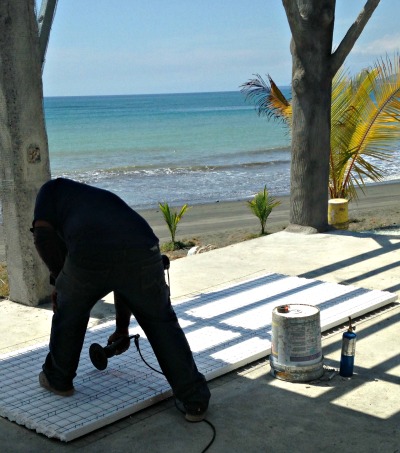
primarily for interior and exterior walls and sometimes for flooring or the roof.
M2 is used in place of concrete blocks, but must be “stucco coated” or "repello" with concrete.
M2 is increasingly popular and allows building to go up very quickly. Some people import higher quality M2 panels than are available in Panama. But most are successful using the locally available M2 panels.
M2 panels come in different thickness. Ideally, you should use panels at least 4 inches thick. Panels thinner than 4 inches have a tendency to buckle and are not load bearing.
Plycem is a fiber cement board widely used to replace wood siding, plywood, tile base in showers, and, at times, sheetrock. It can be cut, sanded, nailed, rough dressed, drilled and screwed with conventional woodworking tools.

There is a similar product to Plycem available in the States. It is called Hardiboard.
Benefits of Plycem
Plycem is designed to be screwed into wood or steel studs and floor joists. 3/4 or 1" Plycem can even replace plywood floors, when placed on closely spaced floor framing using steel studs or wood.
In our own house, we have used Plycem as the base for a tiled kitchen floor as well as for the floor and walls of our bathrooms.
Thanks.